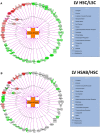Monoclonal Antibody to Marinobufagenin Downregulates TGFβ Profibrotic Signaling in Left Ventricle and Kidney and Reduces Tissue Remodeling in Salt-Sensitive Hypertension
- PMID: 31576777
- PMCID: PMC6818028
- DOI: 10.1161/JAHA.119.012138
Monoclonal Antibody to Marinobufagenin Downregulates TGFβ Profibrotic Signaling in Left Ventricle and Kidney and Reduces Tissue Remodeling in Salt-Sensitive Hypertension
Erratum in
-
Correction to: Monoclonal Antibody to Marinobufagenin Downregulates TGFβ Profibrotic Signaling in Left Ventricle and Kidney and Reduces Tissue Remodeling in Salt-Sensitive Hypertension.J Am Heart Assoc. 2022 Oct 4;11(19):e020832. doi: 10.1161/JAHA.119.020832. Epub 2022 Sep 29. J Am Heart Assoc. 2022. PMID: 36172940 Free PMC article. No abstract available.
Abstract
Background Elevated levels of an endogenous Na/K-ATPase inhibitor marinobufagenin accompany salt-sensitive hypertension and are implicated in cardiac fibrosis. Immunoneutralization of marinobufagenin reduces blood pressure in Dahl salt-sensitive (Dahl-S) rats. The effect of the anti-marinobufagenin monoclonal antibody on blood pressure, left ventricular (LV) and renal remodeling, and gene expression were investigated in hypertensive Dahl-S rats. Methods and Results Dahl-S rats were fed high NaCl (8%, HS; n=14) or low NaCl (0.1%, LS; n=14) diets for 8 weeks. Animals were administered control antibody (LS control antibody, LSC; HS control antibody, HSC; n=7 per group) or anti-marinobufagenin antibody once on week 7 of diet intervention (n=7 per group). Levels of marinobufagenin, LV, and kidney mRNAs and proteins implicated in profibrotic signaling were assessed. Systolic blood pressure was elevated (211±8 versus 133±3 mm Hg, P<0.01), marinobufagenin increased 2-fold in plasma (P<0.05) and 5-fold in urine (P<0.01), LV and kidney weights increased, and levels of LV collagen-1 rose 3.5-fold in HSC versus LSC. Anti-marinobufagenin antibody treatment decreased systolic blood pressure by 24 mm Hg (P<0.01) and reduced organ weights and level of LV collagen-1 (P<0.01) in hypertensive Dahl salt-sensitive rats with anti-marinobufagenin antibody versus HSC. The expression of genes related to transforming growth factor-β-dependent signaling was upregulated in the left ventricles and kidneys in HSC versus LSC groups and became downregulated following administration of anti-marinobufagenin antibody to hypertensive Dahl-S rats. Marinobufagenin also activated transforming growth factor-β signaling in cultured ventricular myocytes from Dahl-S rats. Conclusions Immunoneutralization of heightened marinobufagenin levels in hypertensive Dahl-S rats resulted in a downregulation of genes implicated in transforming growth factor-β pathway, which indicates that marinobufagenin is an activator of profibrotic transforming growth factor-β-dependent signaling in salt-sensitive hypertension.
Keywords: Dahl salt‐sensitive hypertension; cardiac hypertrophy; marinobufagenin; monoclonal antibody; transforming growth factor.
Figures








Similar articles
-
Effect of Cardiotonic Steroid Marinobufagenin on Vascular Remodeling and Cognitive Impairment in Young Dahl-S Rats.Int J Mol Sci. 2022 Apr 20;23(9):4563. doi: 10.3390/ijms23094563. Int J Mol Sci. 2022. PMID: 35562955 Free PMC article.
-
Dietary Sodium Restriction Reduces Arterial Stiffness, Vascular TGF-β-Dependent Fibrosis and Marinobufagenin in Young Normotensive Rats.Int J Mol Sci. 2018 Oct 15;19(10):3168. doi: 10.3390/ijms19103168. Int J Mol Sci. 2018. PMID: 30326586 Free PMC article.
-
Xanthine Oxidase Inhibitor, Febuxostat Ameliorates the High Salt Intake-Induced Cardiac Hypertrophy and Fibrosis in Dahl Salt-Sensitive Rats.Am J Hypertens. 2019 Jan 1;32(1):26-33. doi: 10.1093/ajh/hpy143. Am J Hypertens. 2019. PMID: 30277494
-
Benidipine inhibits expression of ET-1 and TGF-beta1 in Dahl salt-sensitive hypertensive rats.Hypertens Res. 2001 May;24(3):241-50. doi: 10.1291/hypres.24.241. Hypertens Res. 2001. PMID: 11409647
-
Marinobufagenin, an endogenous alpha-1 sodium pump ligand, in hypertensive Dahl salt-sensitive rats.Hypertension. 2001 Feb;37(2 Pt 2):462-6. doi: 10.1161/01.hyp.37.2.462. Hypertension. 2001. PMID: 11230319
Cited by
-
New Insights on the Role of Marinobufagenin from Bench to Bedside in Cardiovascular and Kidney Diseases.Int J Mol Sci. 2023 Jul 6;24(13):11186. doi: 10.3390/ijms241311186. Int J Mol Sci. 2023. PMID: 37446363 Free PMC article. Review.
-
Endogenous bufadienolides, mineralocorticoid receptor antagonists and fibrosis in chronic kidney disease.Front Pharmacol. 2024 Sep 4;15:1431216. doi: 10.3389/fphar.2024.1431216. eCollection 2024. Front Pharmacol. 2024. PMID: 39295945 Free PMC article. Review.
-
Effect of Cardiotonic Steroid Marinobufagenin on Vascular Remodeling and Cognitive Impairment in Young Dahl-S Rats.Int J Mol Sci. 2022 Apr 20;23(9):4563. doi: 10.3390/ijms23094563. Int J Mol Sci. 2022. PMID: 35562955 Free PMC article.
-
2-phenylacetamide Separated from the seed of Lepidium apetalum Willd. inhibited renal fibrosis via MAPK pathway mediated RAAS and oxidative stress in SHR Rats.BMC Complement Med Ther. 2023 Jun 23;23(1):207. doi: 10.1186/s12906-023-04012-w. BMC Complement Med Ther. 2023. PMID: 37353787 Free PMC article.
-
The Na/K-ATPase Signaling and SGLT2 Inhibitor-Mediated Cardiorenal Protection: A Crossed Road?J Membr Biol. 2021 Dec;254(5-6):513-529. doi: 10.1007/s00232-021-00192-z. Epub 2021 Jul 23. J Membr Biol. 2021. PMID: 34297135 Free PMC article. Review.
References
-
- Folkow B. Physiological aspects of primary hypertension. Physiol Rev. 1982;62:347–504. - PubMed
-
- Weinberger MH, Miller JZ, Luft FC, Grim CE, Fineberg NS. Definitions and characteristics of sodium sensitivity and blood pressure resistance. Hypertension. 1986;8:II127–II134. - PubMed
-
- Wasserstrom JA, Aistrup GL. Digitalis: new actions for an old drug. Am J Physiol Heart Circ Physiol. 2005;289:H1781–H1793. - PubMed
-
- de Wardener HE, Clarkson EM. Concept of natriuretic hormone. Physiol Rev. 1985;65:658–759. - PubMed
-
- Fedorova OV, Talan MI, Agalakova NI, Lakatta EG, Bagrov AY. Endogenous ligand of alpha(1) sodium pump, marinobufagenin, is a novel mediator of sodium chloride–dependent hypertension. Circulation. 2002;105:1122–1127. - PubMed
Publication types
MeSH terms
Substances
LinkOut - more resources
Full Text Sources
Medical
Molecular Biology Databases

